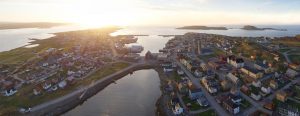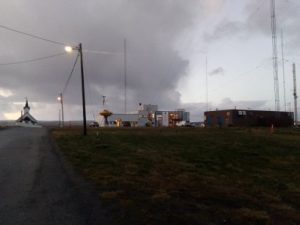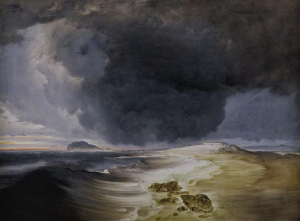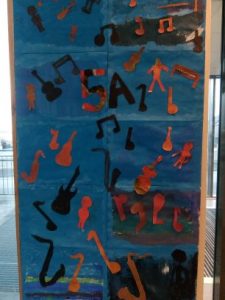For the final part of the visit, I stayed in Tromsø, where I continued with interviews. During the time in Norway, I visited a few museums, and I wanted to share a few photos and thoughts here.
Before leaving Oslo, I visited the Norwegian Maritime Museum. The Museum holds an important collection documenting Norwegian maritime history and coastal culture and the exhibitions highlight the importance of shipping throughout the history of Norway.
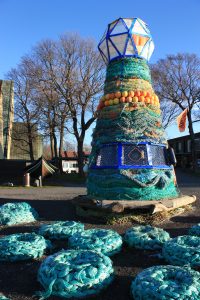 Lighthouse made of old fishing nets outside the Maritime Museum.
Lighthouse made of old fishing nets outside the Maritime Museum.
The final exhibition illustrated the importance of shipping in Norway today, with the slogan “Norway is the Sea”. Throughout the exhibition, the competence and experience of the Norwegian maritime industry, including the seafarers and fishermen, was highlighted. Shipping was shown as the driving force of the petroleum industry, put simply “No ships, no oil”.
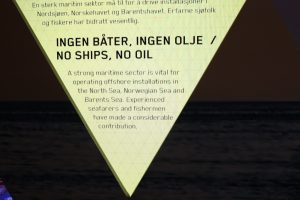 The Norwegian Maritime Museum.
The Norwegian Maritime Museum.
The exhibition gave a good introduction to the different types of vessels needed in offshore oil productions, from surveying boats to tug supply ships to tankers transporting oil.
Miniature models of the old and new boats, as well as platforms, were displayed, including a heavy lift vessel designed for carrying the actual platforms…I don’t have a good photo of the model, but on google, you can find a photo of a similar vessel. This is a photo of Goliat platform being transported – the Goliat oilfield is the world’s northernmost offshore development, situated around 85 km Northwest from Hammerfest.
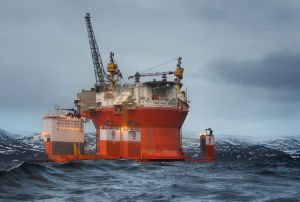 (Source: https://news.nationalgeographic.com/energy/2015/04/150423-arctic-oil-rig-goliat-eni-statoil-norway-global-warming/)
(Source: https://news.nationalgeographic.com/energy/2015/04/150423-arctic-oil-rig-goliat-eni-statoil-norway-global-warming/)
A contrasting perspective to natural resource use was presented by Tromsø University Museum. The museum displays two Sami exhibitions – one on cultural traditions and the other on the political awakening among Sami in Norway after the Second World War.
The Norwegian Sami Parliament is the representative body for people of Sami heritage in Norway and it was created in 1989. The Parliament was created after a major conflict over the damning of the Alta river in Finnmark in 1970-1980’s. The Norwegian government has also ratified the UN Convention on indigenous peoples’ rights (ILO 169), which guarantees, for example, consultations with the Sami when deciding on large-scale projects that could affect Sami livelihoods. The Finnmark Act is based on the ILO 169 and guarantees the Sami the rights to land resources, but does not cover the right to marine resources, which are managed as national property.
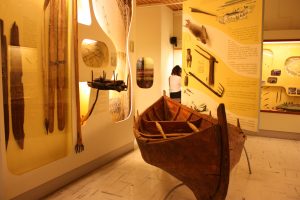 The coastal Sami depended on fishing and small-scale farming.
The coastal Sami depended on fishing and small-scale farming.
The museum collections tell the story of how the Sami have been able to develop a collective identity and interests (with common language traditions, and a shared history and culture), even though they have no national borders or a state of their own.
During my final day in Tromsø, I had an interview with one of the representatives of the Norwegian Sami Parliament. He highlighted the active role Sami have in fighting against climate change: the Parliament takes part in the UN Climate Convention negotiations. The Sami Council, on the other hand, represents Sami communities in the Arctic Council.
Finally, I learned a bit about modern Sami culture, I leave you with link to a music video:
“This is my land” by Sofia Jannok
https://www.youtube.com/watch?v=riXVuhlMNQA
—-
Now, I am already back home and I have been transcribing the interviews and going through the causal networks drawn by the participant. During the trip, I didn’t manage to interview all the participants I had wanted, so a few more interviews will be carried by Skype. I hope to write a few notes about this later 😊
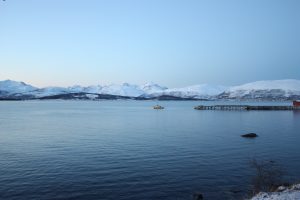 View from Telegrafbukta, Tromsø
View from Telegrafbukta, Tromsø


